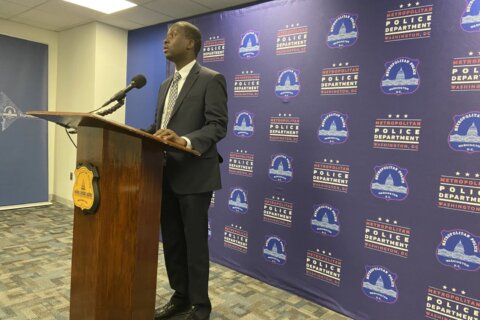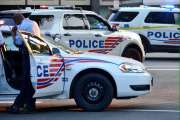WASHINGTON — The most recent data from the District Department of Transportation shows 12 bridges in Washington have structural deficiencies. That’s the fewest in decades. Still, many of Washington’s busiest bridges are in need of help while planned bridge rehabilitation and replacement projects are overshadowed by uncertainty over money.
The “structurally deficient” rating does not mean that a bridge is unsafe. “It establishes that there is deterioration to one or more of the bridge’s major components, which is/are then monitored and corrective actions are taken as necessary. … Bridges are classified based on structural evaluation of the deck, as well as superstructure and substructure of a bridge,” says DDOT spokesman Keith St. Clair.
“The decision to designate a bridge as ‘structurally deficient’ is made by DDOT engineers following inspection and based on the National Bridge Inspection Standards that are accepted by the Federal Highway Administration,” he adds.
St. Clair says the agency has budgeted more than $36 million to improve nine bridges, which include:
- 16th Street NW above Military Road;
- East Capitol Street Bridge/Whitney Young Bridge above the Anacostia River;
- I-295 above Nicholson Street/Anacostia Park;
- Sousa Bridge/Pennsylvania Avenue ramp to southbound DC-295;
- Benning Road ramp to northbound DC-295/Kenilworth Avenue;
- I-295 above Suitland Parkway;
- I-66/Potomac Freeway to outbound Whitehurst Freeway above Rock Creek;
- 31st Street above the C&O Canal;
- 27th Street above Broad Branch.
“These bridges are in various stages of the remedial process; some are still in the design stage, with work already being done at others,” St. Clair says. He points to the accelerated 16th Street NW Bridge Project at Military Road as a recent example of DDOT’s efforts to stay on top of the city’s infrastructure needs.
The National Park Service is in charge of three additional bridges that have been deemed structurally deficient:
- Arlington Memorial Bridge
- Rock Creek Parkway/Parkway Drive near Lincoln Memorial
- Joyce Road above Luzon Branch
Above the Anacostia River, the South Capitol Street Bridge is nearing the end of its time in service. Major repairs were recently made to the 65-year-old structure to extract a few more years out of its life before a total replacement planned for 2020.
In 2007, the South Capitol Street Bridge, also known as the Frederick Douglass Memorial Bridge, was closed to traffic at its northern end while an old elevated approach was rebuilt. It reopened to traffic days before the first game at Nationals Park in 2008.
During routine testing in April 2013, the bridge’s swing span became stuck in an open position, closing South Capitol Street on both sides of the river for hours. A recent inspection in March found the structure in “fair” condition.
The nearby John Philip Sousa Bridge, at 73 the oldest of the Anacostia River crossings, was itself deemed structurally sound after an inspection in July 2014, but two elevated bridges at its eastern end near D.C. Route 295 have been deemed deficient. Both of these overpasses span a small access road to Anacostia Park; one connects the outbound side of the Sousa Bridge to the southbound lanes of D.C. Route 295.
The Sousa Bridge carries Pennsylvania Avenue SE above the Anacostia River in “fair” condition.
The Sousa Bridge’s neighbor to the north, a weathered East Capitol Street Bridge, stands in desperate need of rehabilitation. The 60-year-old bridge was found to be structurally deficient following a December 2013 inspection.
St. Clair says the city has been performing preventive maintenance repairs to extend the service life of the structure until scheduled rehabilitation is done in 2018. The bridge, dedicated to civil rights activist Whitney Young in 1974, is due for a second inspection by the end of this year.
The Benning Road Bridge above the Anacostia River does not have any glaring deficiencies, but the Benning Road ramp onto the northbound lanes of D.C. Route 295 is labeled as structurally deficient. This elevated ramp threads outbound traffic above the southbound lanes of DC 295 but below the through lanes of Benning Road. The Benning Bridge is one of the oldest bridge sites in Washington, with records dating back to the early 1800s.
There is at least one infrastructure success story at the Anacostia: The 11th Street Bridge is the newest bridge complex in the city. Just four years ago stood two dilapidated, incongruous structures built in the 1960s; today, three wider, stronger structures span the river. DDOT says the rebuilding of the bridge also remedied a large gap in the region’s freeway design caused by the termination of planned projects such as the Barney Circle Freeway Project.
“It has provided the missing interstate connections between I-695 (also known as the Southeast-Southwest Freeway) and DC-295. It has also improved pedestrian and bicycle safety, accessibility and mobility for the Anacostia community, connecting neighborhoods to jobs,” St. Clair says.
Emergency repairs are underway at the Arlington Memorial Bridge, which belongs to the National Park Service, after years of delay led to the discovery of significant corrosion last month. That’s a scenario that has played out for many city bridges that long ago exceeded their life expectancy. The other two are the bridge on Rock Creek Parkway over the NPS storage area, and Joyce Road over Luzon Branch.
Above the Potomac River, the Memorial Bridge’s four companions remain in fair condition. The 78-year-old Chain Bridge was last inspected in 2013. No deficiencies were found at the time.
The neoclassical Key Bridge, between Georgetown and Rosslyn, is Washington’s oldest river bridge. Standing for more than 90 years, the Key Bridge has teetered on the edge of a structurally deficient rating for years. Another round of rehabilitation is set to take place this fall.
The Interstate 66 Roosevelt Bridge underwent preservation repairs in 2013. Its most recent inspection in 2014 revealed some of its elements are still in need of rehabilitation. Repairs have been pushed back to 2021.
One of the busiest bridge complexes in the city, the 14th Street Bridge, is composed of three separate highway spans, each built in the mid-20th century. Five years ago, DDOT launched a $27 million rehabilitation project focused on the restoration of the northbound mainline span. The project lasted longer than planned, dragging into mid-2011 while commuters endured traffic-clogging lane closures.
As soon as the dust settled, additional shortcomings became apparent when the bridge was re-inspected in October 2014. Another round of rehab is slated for 2020.
Hari Aamidala, with the engineering consulting firm Parsons Brinckerhoff, is focused on bridge rehabilitation and replacement in D.C. area for clients such as DDOT. In the past year, as a bridge specialist for the American Society of Civil Engineers’ DC Infrastructure Report Card effort, Aamidala worked with DDOT and NPS in evaluating Washington’s aging bridge infrastructure.
“There are a significant amount of bridges that are well over 50 years old in D.C. There’s about 160 bridges, which is 60 percent, that are functionally obsolete.”
Aamidala says that this designation also doesn’t mean that the bridge is unsafe, but implies that its design is outdated when gauged against modern construction technique.
A major obstacle to repairing these bridges is money.
The District’s Highway Trust Fund (HTF), which supports maintenance and repair, Aamidala says, derives roughly 80 percent of its funding from the now-insolvent U.S. Highway Trust Fund. More than half the 209 DDOT bridges in the District are eligible for federal money, which is far more than any state.
“Most of their large projects depend on that funding. When you look at their inventory, where we have about 70 bridges that are in fair condition – that could further deteriorate – it is really important that Congress fixes the Highway Trust Fund so that the future funding to support bridge rehabilitation projects in D.C. is not in jeopardy. And that applies to bridges across the country.”
In decades past, short-term bailouts have delayed the fund’s demise, but have inhibited local governments from properly planning bridge rebuilding projects that typically require several years to complete.
Plans to repair or replace Washington’s aging bridges will likely further be delayed while the future of the HTF sits in limbo.








